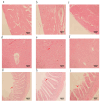Effect of Solid-State Fermentation Products of Lactobacillus plantarum, Candida utilis, and Bacillus coagulans on Growth Performance of Broilers and Prevention of Avian Colibacillosis
- PMID: 39453060
- PMCID: PMC11511520
- DOI: 10.3390/vetsci11100468
Effect of Solid-State Fermentation Products of Lactobacillus plantarum, Candida utilis, and Bacillus coagulans on Growth Performance of Broilers and Prevention of Avian Colibacillosis
Abstract
This study investigates the impact of the solid-state fermentation products of Lactobacillus plantarum, Candida utilis, and Bacillus coagulans (LCBs) on the growth characteristics, immune function, intestinal morphology, cecum microbial community, and prevention of avian colibacillosis in broilers. One hundred and twenty Hyland Brown broilers (aged one day) were divided randomly into three groups (four replicates of ten broilers per group). (1) The CON group was fed a basal diet. (2) The MOD group was fed a basal diet. On day 40, APEC strain SX02 (1.1 × 105 CFU/g) was administered to the breasts of chickens in this group. (3) The LCBs group was fed a basal diet supplemented with fermentation products (98.5% basal diet + 0.5% Lactobacillus plantarum and Candida utilis solid-state fermentation products + 1.0% Bacillus coagulans solid-state fermentation products). On day 40, the LCBs group received the same treatment as the MOD group. The experiment lasted 43 days. This study found that the average daily gain (ADG) of the LCBs group was significantly higher than that of the MOD group (p < 0.05), indicating that LCBs can significantly increase the ADG of broilers and improve the feed conversion ratio. Furthermore, compared to the MOD group, the heart bacterial load was significantly reduced in the LCBs group (p < 0.05), and the lesions less severe in the heart, liver, and jejunum were observed (p < 0.05). Additionally, the detection of intestinal flora showed a significant increase in the abundance of beneficial bacteria in the cecum of the LCBs group, while the number of Escherichia coli and Shigella decreased significantly. In conclusion, the solid fermentation of Lactobacillus plantarum, Candida utilis, and Bacillus coagulans can improve the growth performance of broilers while also protecting against avian pathogenic Escherichia coli infection. This demonstrates the potential usefulness of these LCBs in feed production.
Keywords: Bacillus coagulans; Candida utilis; Lactobacillus plantarum; avian pathogenic Escherichia coli.
Conflict of interest statement
The authors declare no conflicts of interest.
Figures






References
-
- Dai P., Wu H., Ding G., Fan J., Li Y., Li S., Bao E., Li Y., Gao X., Li H., et al. Recombinant Salmonella gallinarum (S. gallinarum) Vaccine Candidate Expressing Avian Pathogenic Escherichia coli Type I Fimbriae Provides Protections against APEC O78 and O161 Serogroups and S. gallinarum Infection. Vaccines. 2023;11:1778. doi: 10.3390/vaccines11121778. - DOI - PMC - PubMed
Grants and funding
LinkOut - more resources
Full Text Sources

